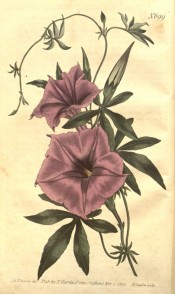Ipomoea cairica (L.) Sw.
Frost tender, tuberous-rooted perennial climber with palmate leaves and profuse funnel-shaped flowers in red, purple or white, with purple inside the tube. To 4.5m. [RHSD, Hortus, FNSW].
Horticultural & Botanical History
‘[Convolvulus cairicus] is most probably the plant originally meant by Linnaeus, though perhaps afterwards confounded by Murray, in the Syst. Vegetab. We have little doubt of its being the same as described by Vesling and Forskall, and said by them to be a very common ornamental plant in the gardens of Egypt, but perhaps not indigenous there.’ [BM t.699/1803]. Ipomoea pendula was introduced to Britain from Australia in 1805, and I. cairica from Egypt in 1680. [JD]. Don reports that it was found in ‘New Holland, within the tropic; and in New South Wales, about Port Jackson, as well as New Caledonia.’ BR f.632/1822.
History at Camden Park
Listed in all published catalogues [H.117/1843]. Possibly obtained from within Australia. Ipomoea cairica (L.) Sw. is widely distributed in the Sydney region but it may be an introduction [Beadle]. Regarded as a garden escape in the Flora of New South Wales [FNSW vol.3, p.380].
Notes
Published Oct 04, 2009 - 04:27 PM | Last updated Jul 16, 2010 - 03:32 PM
| Family | Convolvulaceae |
|---|---|
| Category | |
| Region of origin | Tropical Africa, Asia |
| Synonyms |
|
| Common Name | Perennial Morning Glory |
| Name in the Camden Park Record | Ipomoea pendula |
| Confidence level | high |
